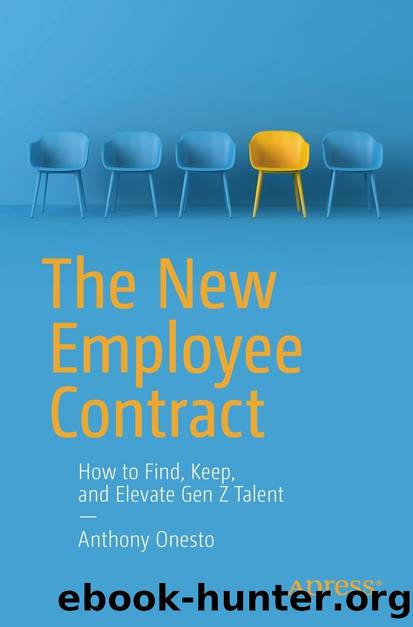The New Employee Contract by Anthony Onesto

Author:Anthony Onesto
Language: eng
Format: epub
ISBN: 9781484280546
Publisher: Apress
5.2 The Job They Started with Wonât Be the Job They Finish With
So, think of the employee as less âtruck driverâ and more âtruck driver for a couple of yearsâ with your employees constantly rotating between tasks, projects, and departments.
The advantage here is that instead of having an employee with a very narrow, strictly defined set of skills, you grow workers with flexibility, motivation, and a real connection to your workplace.
If youâre an HR person reading this, your head might be spinning right now. The way we think of employees in predefined roles, within a predefined organizational chart, is fundamentally incompatible with this new model. Thatâs the bad news. The good news is that an HR personâs role within an organization will become increasingly important, as there will need to be dedicated resources to help employees search for and find these untapped skills and desires that would make them happy while also being beneficial to the organization.
The CEO may be the visionary coach of the company. Sure, but the HR department is the quarterback on the field, ensuring everyone is in the right position and where their skills are needed at that present time. If those employees are not correctly positioned, itâs going to be up to that HR department to help steer them to a better position where they are happier and more productive, creating a win-win situation for the entire organization.
I suspect it will be the case as we go deeper into this century and the next that you might find the idea of a lifetime employee just doesnât exist anymore. Even if the employee today does now move within the organization and changes titles and tasks every couple of years, they may still leave. That doesnât mean youâll never see them againâquite the opposite.
Instead, what we may find is that you increasingly hire an employee for a specific project, make sure they are compensated well, and work with them to transition to a different set of responsibilities after that initial project is completed. Those responsibilities may very well be for another organization. Doing so may sound confusing at first, but in the long run it will have created a new bond of loyalty for your employees. (Hey, how do you think the top consulting firms stay on top?) If you were paying attention earlier, youâll know that McKinsey, WPP, and others are constantly pushing out their employees to other organizations, which then once positioned there hire back those firms and give them more work. So, Iâm not exactly reinventing the wheel here. Iâm just saying more organizations and employees should work symbiotically with each other since thatâs the mode Gen Z prefers anyway with their desire for constant change.
Helping Gen Z employees to find work elsewhere and leaving the door open for their return also removes the acrimonious breakup of quitting or getting fired that no one likes to deal with. This fluid movement through the organization, and out of it, instead creates a relationship that can be renewed in the future.
Download
This site does not store any files on its server. We only index and link to content provided by other sites. Please contact the content providers to delete copyright contents if any and email us, we'll remove relevant links or contents immediately.
The Art of Thinking Clearly by Rolf Dobelli(10217)
Mindhunter: Inside the FBI's Elite Serial Crime Unit by John E. Douglas & Mark Olshaker(9200)
Change Your Questions, Change Your Life by Marilee Adams(7635)
Nudge - Improving Decisions about Health, Wealth, and Happiness by Thaler Sunstein(7615)
Mastermind: How to Think Like Sherlock Holmes by Maria Konnikova(7227)
The Power of Now: A Guide to Spiritual Enlightenment by Eckhart Tolle(5605)
Men In Love by Nancy Friday(5155)
Altered Sensations by David Pantalony(5045)
Factfulness: Ten Reasons We're Wrong About the World – and Why Things Are Better Than You Think by Hans Rosling(4694)
The Confidence Code by Katty Kay(4187)
Thinking in Bets by Annie Duke(4152)
Man and His Symbols by Carl Gustav Jung(4067)
The Worm at the Core by Sheldon Solomon(3433)
Why Buddhism is True by Robert Wright(3403)
Liar's Poker by Michael Lewis(3368)
Three Women by Lisa Taddeo(3354)
The Inner Life of Animals by Peter Wohlleben(3259)
Descartes' Error by Antonio Damasio(3229)
How Music Works by David Byrne(3186)
